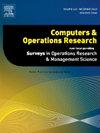Stochastic casualty response planning with multiple classes of patients
IF 4.3
2区 工程技术
Q2 COMPUTER SCIENCE, INTERDISCIPLINARY APPLICATIONS
引用次数: 0
Abstract
In this paper, we study the stochastic casualty response planning problem (CRP) in the context of providing treatments to multiple classes of patients with different types of injuries. In this general setting, both patients’ demands and hospitals’ treatment capacity are considered uncertain. To the best of our knowledge, this is the first time that this problem is solved. We propose a novel two-stage stochastic mixed-integer programming model which, in the first stage, determines the location of the Alternative Care Facilities (ACFs) and allocates different resources, such as rescue vehicles, medical equipment, and physicians, to them. In the second stage, this model helps decide how to allocate patients with multiple injuries to either ACFs or hospitals, considering their care itineraries and available resources. Moreover, it recommends potential patient transfers between ACFs and hospitals when required. Furthermore, we introduce an alternative two-stage stochastic model that is more compact than the first. This formulation significantly reduces solution times. We also provide an equivalency proof between the two formulations. As the solution method, we develop both the L-shaped algorithm, a pure cutting-plane method tailored to our stochastic mathematical model, and the branch-and-Benders-cut (B&BC) algorithm. To further enhance the efficiency of these algorithms, we develop a wide range of acceleration techniques, including Benders dual decomposition, Lagrangian dual decomposition, a multi-cut reformulation, Pareto-optimal cuts, and the inclusion of lower bounding functional valid inequalities. We carry out extensive computational experiments demonstrating that these algorithmic enhancements dramatically improve the performance of the B&BC algorithm, reducing the average optimality gap from 7898% in the standard B&BC algorithm to just 0.92% in the enhanced version. Additionally, we benchmark our approach against the progressive hedging algorithm (PHA), a widely used decomposition method in disaster response operations, to further assess its effectiveness. Finally, we present a case study from the 2011 Van earthquake in Turkey, demonstrating the applicability and efficiency of our optimization methods.
多类别病人随机伤亡应变计划
本文研究了针对多类不同类型损伤患者提供治疗的随机伤亡响应计划问题(CRP)。在这种一般情况下,患者的需求和医院的治疗能力都被认为是不确定的。据我们所知,这是这个问题第一次得到解决。我们提出了一种新的两阶段随机混合整数规划模型,该模型在第一阶段确定替代护理设施(ACFs)的位置,并为其分配不同的资源,如救援车辆、医疗设备和医生。在第二阶段,该模型帮助决定如何将多重损伤患者分配到ACFs或医院,考虑他们的护理行程和可用资源。此外,它还建议必要时在ACFs和医院之间进行潜在的患者转移。此外,我们引入了一个替代的两阶段随机模型,它比第一个更紧凑。该配方显著减少了溶液时间。我们还提供了两个公式之间的等价证明。作为求解方法,我们开发了l形算法,这是一种适合我们随机数学模型的纯切割平面方法,以及分支-弯曲切割(B&;BC)算法。为了进一步提高这些算法的效率,我们开发了广泛的加速技术,包括Benders对偶分解、拉格朗日对偶分解、多切割重构、帕累托最优切割和包含下界泛函有效不等式。我们进行了大量的计算实验,证明这些算法增强显着提高了B&;BC算法的性能,将平均最优性差距从标准B&;BC算法的7898%减少到增强版本的0.92%。此外,我们将我们的方法与渐进式对冲算法(PHA)(一种在灾害响应操作中广泛使用的分解方法)进行基准测试,以进一步评估其有效性。最后,以2011年土耳其范地震为例,验证了优化方法的适用性和有效性。
本文章由计算机程序翻译,如有差异,请以英文原文为准。
求助全文
约1分钟内获得全文
求助全文
来源期刊

Computers & Operations Research
工程技术-工程:工业
CiteScore
8.60
自引率
8.70%
发文量
292
审稿时长
8.5 months
期刊介绍:
Operations research and computers meet in a large number of scientific fields, many of which are of vital current concern to our troubled society. These include, among others, ecology, transportation, safety, reliability, urban planning, economics, inventory control, investment strategy and logistics (including reverse logistics). Computers & Operations Research provides an international forum for the application of computers and operations research techniques to problems in these and related fields.
 求助内容:
求助内容: 应助结果提醒方式:
应助结果提醒方式:


